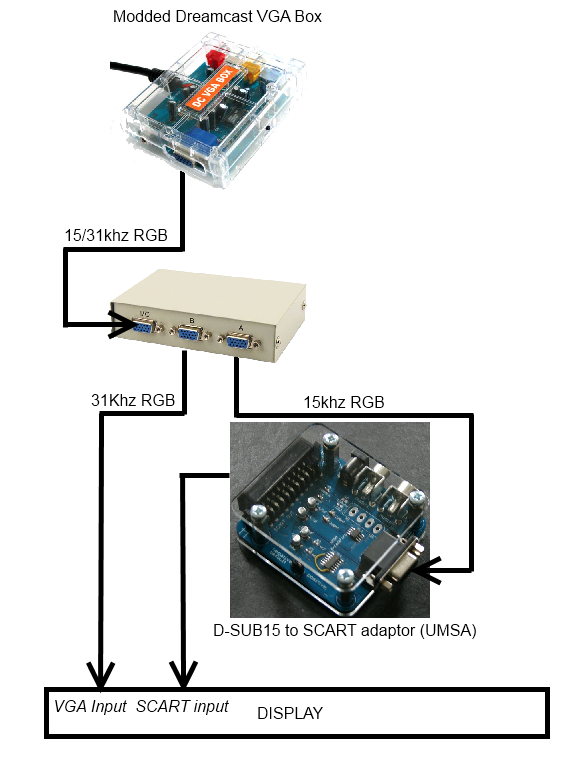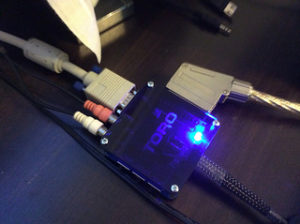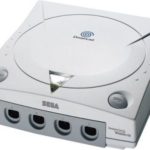Console Guides, Howto & Guides
Dreamcast universal VGA/RGB box
The Sega Dreamcast is much loved amongst retro gamers and rightly so. As the very last games console that Sega launched, it played host to some of the most innovative and quirky titles of the generation. Unlike the PS2, with it’s poor quality component video output or the Gamecube with it’s ultra rare component cables, the Dreamcast offers wonderful, crisp 640×480 31khz RGB on the bulk of its games. All that is needed to play games in VGA is a Dreamcast VGA box or cable. Unfortunately, VGA isn’t available for every game and this presents something of a problem. To swap back to regular RGB via SCART means a cable swap, one that can cause wear and tear on both your Dreamcast VGA box and the Dreamcast’s AV port. Some Dreamcast VGA boxes offer composite video or S-Video output too, but of course the quality of these connections is never as good as RGB.
The D-Sub 15 connector commonly referred to as “VGA” is not limited to carrying the 31khz RGB signal that the Dreamcast outputs in VGA mode. D-Sub 15 cables are more than capable of carrying 15khz signals too, although this is deliberately locked out in the VGA box hardware.
Unlocking 15khz from the VGA box
Sega’s decision to limit the VGA box output to 31khz was probably made to avoid consumer confusion. The bulk of PC monitors and HDTV’s only accept 31khz signals via their VGA connectors. However there are a number of devices (the XRGB3 for instance and the XRGB Mini too) that will accept both kinds of signal on the same connector. Some displays (for instance HDTV’s in Europe) have inputs for both 31khz VGA and 15khz RGB SCART. While the processing of 15khz signals is often less than stellar on these sets, it can still be acceptable where no alternative exists and is usually way better than using either composite or S-Video.
What is needed is some way of enabling both 15khz and 31khz from the VGA box. This can then be fed into a compatible processor or split with a simple VGA switch, thus avoiding wear and tear on your Dreamcast. Fortunately this is relatively easy to do. Rather than reprinting the information here, simply take a look at this thread over on the Arcade Otaku forum. The modification should be easy for anyone who is the least bit competent with soldering. If you don’t want to do it for yourself then most game console modders will undertake the work for you.
Once you have completed this modification, the next step depends on what equipment you intend to use. For the XRGB3 you can simply connect the VGA cable into the D in 2 connector on the back of the XRGB3. For the XRGB Mini, you will need some way of converting the D-Sub 15 (VGA) connector into something that can connect to the Mini’s RGB port. You could solder your own custom cable solution using the pin-outs given on the page above. You could use an Extron RGB interface and a simple SCART break-out adapter. Alternatively, if you already have a SCART adaptor for your mini, use ArcadeForge’s UMSA SCART adapter to convert the D-Sub 15 connection to SCART.
If you are using a display with a separate RGB SCART and VGA connector, you will need some way of splitting the output from the Dreamcast into two. The easiest way to do this is by using a simple VGA switch-box. The passive VGA switches such as this one are bi-directional and so ideal for use in this project. Connect the Dreamcast into the switch, then connect one output to the VGA socket on your TV. For the second output, you will need a suitable VGA to SCART lead. Remember that most leads that are readily available are SCART to VGA and therefore not suitable. You can solder up your own solution or simply use ArcadeForge’s UMSA. The final setup should look like this:-

Be careful when using this setup, if you set the Dreamcast to VGA (31khz) mode and then feed the signal to your TV’s SCART socket, you could theoretically damage the set. It’s unlikely though, but if you do manage to feed the wrong signal by accident, switch it off as soon as possible.
Toro – An all in one VGA box solution
If the above solution sounds like way too much hassle, you might be interested in the new Toro Dreamcast VGA box. Due for release soon, this box has both a SCART and D-Sub 15 (VGA) style connector. With a flick of a switch it can output both 15khz and 31khz modes via either connector. Take a look at the picture below, which is taken from the official Flickr page here.
 By offering both kinds of connector, the Toro can work with pretty much any gaming setup. If you want to connect to a regular TV, you’d connect both the VGA and SCART cables and simply change input depending on what kind of Dreamcast game you were playing. If you are lucky enough to have an XRGB Mini, you can simply connect the SCART cable directly to the Mini or through your usual SCART switching matrix. The Dreamcast/Toro combination can then send all signals from 240p up to 480p down the SCART cable. If you were thinking “but SCART cannot support 480p” you’re wrong. SCART cables can support 480p just fine, it is just that most displays can’t support anything better than 480i on their SCART inputs.
By offering both kinds of connector, the Toro can work with pretty much any gaming setup. If you want to connect to a regular TV, you’d connect both the VGA and SCART cables and simply change input depending on what kind of Dreamcast game you were playing. If you are lucky enough to have an XRGB Mini, you can simply connect the SCART cable directly to the Mini or through your usual SCART switching matrix. The Dreamcast/Toro combination can then send all signals from 240p up to 480p down the SCART cable. If you were thinking “but SCART cannot support 480p” you’re wrong. SCART cables can support 480p just fine, it is just that most displays can’t support anything better than 480i on their SCART inputs.
The Toro VGA box should be available soon, you can find out more about it by visiting this page.
Other Dreamcast peculiarities
Keep in mind when running the Dreamcast on a modern VGA monitor, or through a VGA to HDMI adapter or scaler that the picture signal is true 480p, that is 720×480 and NOT the typical 640×480 that most displays and converters expect it to be. Many displays will squash the Dreamcast’s picture up into a 640×480 image. To avoid this, use the adjustment controls on your monitor if possible. You can also transcode from VGA to Component (if you can find an affordable transcoder) or use a video processor like the DVDO Edge that supports manually resizing the picture.
Back from Dreamcast Ultimate RGB Box Mod to Home Page



I have the exact same VGA box and the exact opposite problem! Since the day I got it years, the DC VGA BOX has only outputted at 15khz making many of my monitors and tvs unusable. I’m trying to figure out how to enable 31khz. I understand that both pins 6 & 7 must be grounded, and as far as I can tell both are, but I still can’t get it to output 31khz. I’m really confused why no one else is having this issue.
Definitely a fault with the VGA box that should never happen without a mod.